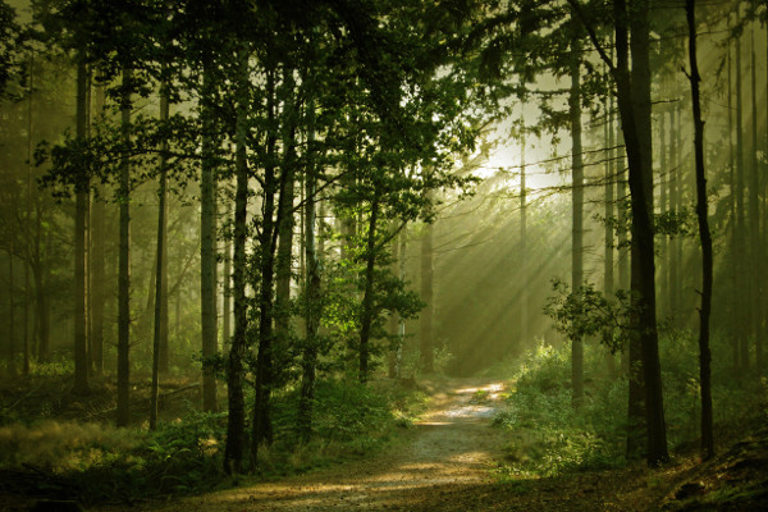It cools us in the summer, it warms our hearts all year,
It provides a home for owls and flowers, for herons, cedars, fir.
It shapes the landscape, painting peace, away from the urban rush,
It protects our water all year round, surrendering it clear and fresh.
In Japanese, the word shinrin means forest and yoku means bath, so shinrin-yoku means ‘forest bath’: being immersed in the forest with all our senses. Listening to its quietness, seeing the variety of trees, mosses, lichens and rocks, tasting the air as you breathe in deeply, touching the rough Douglas fir and the smooth red arbutus, going barefoot across the earth, dipping your feet in a forest stream, lying down to gaze up at its beauty. Such bathing brings healing to the body, heart, mind and soul.
Quite Distressing
So it’s quite distressing to realize how threatened the forest is: threatened by fire, by logging and by clearing for housing and industrial development. The Coastal Douglas fir biogeoclimatic zone that dominates the landscape on the east coast of Vancouver Island is the smallest and most at-risk zone in B.C., with the highest number of species and ecosystems at risk, many of which are ranked globally as imperiled or critically imperiled. Of all the zones in the province it is the most altered by human activity, with less than 1% remaining in an old growth condition and only 9% being protected.
The beauty of our Island’s landscape is shaped by three things: the forest, the farmland, and water. Much of the agricultural land is protected from development by being in the Agricultural Land Reserve. But the privately-owned forest has little or no protection. If a developer wants a chunk of forested land for housing on the north side of Mount Tzouhalem all he has to do is cut the trees and apply for rezoning. There are guidelines for logging on Crown land and private managed forest land, but the only protection private non-managed forests have under the current bylaws is along a riparian zone, close to a river, creek or wetland. For the rest it’s open season, no permits or approvals required. At the Yellow Point Ecological Society (Y.E.S.) we call it ‘ecological abandonment.’
Can we build without tearing into the forest?
We certainly need more housing on the Island, both private and affordable non-profit. It’s the only way to stem the tsunami of price inflation that has knocked the hope out of so many would-be home-buyers, while emptying their bank accounts. There are many urban and suburban areas which could be densified with duplexes and townhouses, however, without needing to tear into the forest.
And there are other ways to manage the forest. At Wildwood, in Yellow Point, Merv Wilkinson managed 77 acres of forest for 60 years using ecoforestry methods that emphasized single-tree selection to maximize light for the Douglas fir trees, shade for the red cedars, wildlife trees for the woodpeckers, and downed trees to become nurse-logs for future trees and habitat for amphibians and fungi. Using these methods, and cutting every five years, Merv extracted more timber over a 60-year cycle than he would have obtained if he had clearcut the forest, while leaving the whole forest standing. The timber was higher quality too, with tighter growth-rings. The forest’s old-growth character is slowly returning, and will continue to do so now that the Ecoforestry Institute is managing Wildwood.
Seven Solutions
At Y.E.S., when we put our thinking hats on, we came up with seven possible ways to protect the forest. We are floating them all to see which gain public support.
- The voluntary use by landowners of ecoforestry covenants, allowing logging using a sustainable management system, including the ecosystem-based method of single-tree selection practiced at Wildwood, supported by the possible formation of local forest cooperatives.
- The use of a conservation property tax incentive to reward landowners who practise voluntary sustainable forest management or who have placed an ecological covenant on their land.
- The use of density transfers, allowing landowners whose zoning allows for subdivision into two or more lots to sell the development potential to a landowner in an area where density transfer units can be received for an approved sustainable development. The Regional District of Nanaimo allows this for transfers into Area H.
- A zoning bylaw requiring clustered development on lots of ten acres or more. A landowner with twenty acres who wanted to develop could cluster four homes on four one-acre lots, instead of the current bylaw allowing four five-acre lots. The rest of the forest would be protected by an ecoforestry covenant.
- The creation by the provincial government of a Coastal Douglas Fir Land Reserve in which logging would be allowed using sustainable ecoforestry methods, guaranteeing landowners’ development rights but requiring clustering as above.
- Amending the development permit area rules to classify all Coastal Douglas fir forest as an endangered ecosystem with the following requirements: permits for any subdivision, clustered development, and the remaining forest to be protected by ecoforestry covenants.
- The development of a regional conservation fund financed by a small increase in everyone’s taxes to fund conservation projects on private lands, and to purchase private properties for conservation purposes.
The Ancient Forest Alliance is also calling for the provincial government to establish a $40-million annual land acquisition fund to buy up and protect more of B.C.’s endangered forests, and the Vancouver Island Water Watch Coalition is calling for changes to the Water Sustainability Act to provide more protection for forests and watersheds.
What do you think? Y.E.S. is hosting a free Forests and Watershed Solutions Forum on Thursday September 20th in Cedar Community Hall. We invite you to come and join the discussion.
Guy Dauncey is President of the Yellow Point Ecological Society. First published in Take 5 Magazine, September 2018





